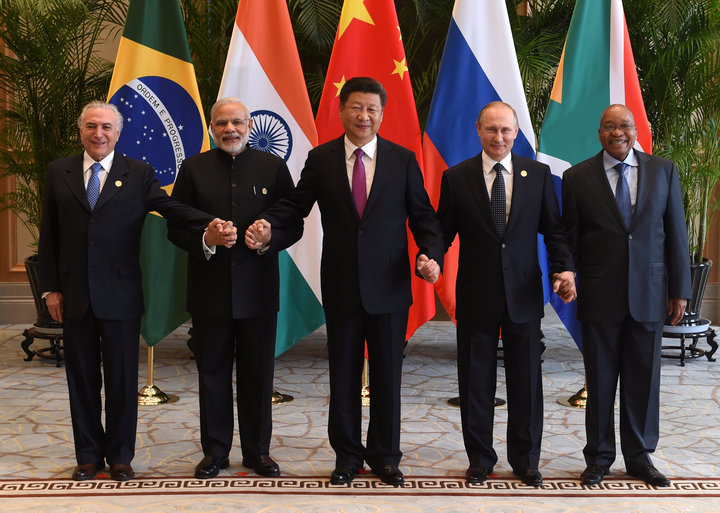‘BRICS China Year’ full of promise

Chinese President Xi Jinping (C) takes a group photo with his BRICS counterparts during the G20 Hangzhou Summit in September 2016. Holding the presidency of the bloc in 2017, China resolves to take BRICS cooperation a step further together with the other four nations.
China took over the presidency of BRICS on Jan. 1, 2017, assuming the leading role of the bloc for the year.
On the same day, Chinese President Xi Jinping sent letters to leaders of the other four BRICS countries, offering a preview of China’s vision for advancing BRICS cooperation during its tenure. This agenda will be put into action at the upcoming ninth BRICS Summit, which is to be held in September this year in the coastal city of Xiamen, Southeast China’s Fujian Province.
“The Xiamen Summit will make progress in the following key aspects: first, deepen pragmatic cooperation to promote common development; second, strengthen global governance to jointly address challenges; third, carry out people-to-people and cultural exchanges to consolidate the public opinion basis; and fourth, promote mechanism building to forge more extensive partnerships,” Xi wrote in the letters.
Xi’s four expectations crystalize China’s resolve to take BRICS cooperation a step further together with the other four nations.
The BRICS countries have engaged in 10 years of cooperation, and 2017 marks the beginning of another decade. Despite weak world economic recovery, the BRICS nations have, through their concrete efforts, defied the predictions of Western media that the bloc would decline, establishing the group as an important engine of world economic growth.
A decade ago, the economic aggregate of the five BRICS countries accounted for 12 percent of the global economy, but they now account for 23 percent. Their share of total trade volume rose from 11 percent to 16 percent, and the share of foreign investment grew from 7 percent to 12 percent. As their economies have boomed, their status has been rising in the international community.
According to the International Monetary Fund, BRICS contribution to world economic growth accounted for more than 50 percent in the past decade.
Over the last 10 years, the BRICS nations have worked to advance their mutual interests. They founded the New Development Bank, established the Contingent Reserve Arrangements, deepened cooperation in energy conservation and energy efficiency improvement, and strengthened the coordination of stances on climate change, opening up a new path of South-South Cooperation.
Meanwhile, the countries have been spreading the BRICS spirit featuring openness, inclusiveness, cooperation and mutual benefit to other emerging and developing countries through dialogues with African and South American countries and such platforms as the Shanghai Cooperation Organization and Eurasian Economic Union.
China is an adamant supporter and participant in the BRICS mechanism, making remarkable contributions to the development of BRICS.
“The BRICS countries collectively are bigger today than even in the most optimistic scenario I thought 15 years ago, and it’s primarily because of China,” British economist Jim O’Neill, who coined the term “BRICS,” told the BBC.
Economically, China has been a veritable bellwether among the BRICS nations. According to the Global Competitiveness Report 2016-2017 released by the World Economic Forum, China continues to lead the way among emerging economies.
In terms of mechanism construction, Chinese leaders proposed a number of substantive and constructive ideas for the deepening of BRICS cooperation in past summits, offering advice to boost the confidence and development of BRICS.
The “BRICS China Year” has started. At the new starting point of BRICS cooperation, China will adhere to the BRICS spirit to embrace opportunities and cope with challenges ahead, driving the BRICS train faster and farther.
This article was translated from People's Daily.
